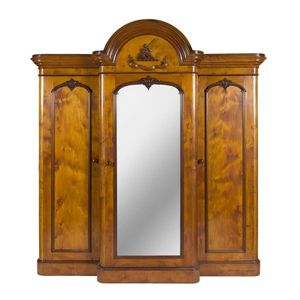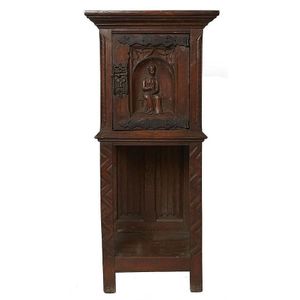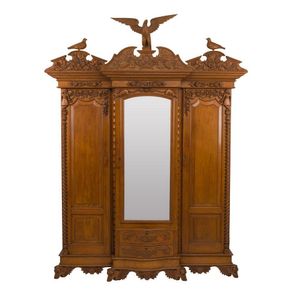Anglo-Ceylonese Teak Carved Breakfront Armoire
You must be a subscriber, and be logged in to view price and dealer details.
Subscribe Now to view actual auction price for this item
When you subscribe, you have the option of setting the currency in which to display prices to $Au, $US, $NZ or Stg.
- Breakfront - A design generally found in larger pieces of furniture, such as bookcases, wardrobes and some sideboards. The line of the front is interrupted by the middle section standing out from each end. In a reverse breakfront, the centre section is recessed behind each end. Breakfronted pieces are usually made in three sections the middle and the two wings which are held together by the cornice and pediment, and the plinth on which it stands. The sensible buyer should show caution before buying breakfront pieces, especially bookcases, which are highly desirable and expensive. Always check that the timber, colour, patination, backboards, decoration and thickness of the wood are same in each section.
- The Eagle - The eagle has been a symbol of power, victory, and strength for centuries. It is often associated with bravery, prowess, and dominance, and has been used as a symbol by many cultures and civilizations throughout history.
In ancient Greece, the eagle was associated with the god Zeus, who was considered the king of the gods and the ruler of the skies. In many cultures, the eagle was seen as a messenger between the physical world and the spirit world, and was associated with the sun and the sky.
In the Roman Empire, the eagle was the symbol of the Roman army, and was displayed on the standards of the soldiers to show the power and authority of the empire. In medieval Europe, the eagle was used as a symbol of power and victory by monarchs and rulers, and was often depicted in art and architecture as a symbol of strength and courage.
In modern times, the eagle continues to be a symbol of power, victory, and strength. It is often used as a symbol by nations and organisations, and is frequently depicted in art and on monuments to commemorate important events and achievements.
The eagle's powerful appearance, combined with its association with freedom, courage, and dominance, makes it a popular and enduring symbol of power and victory.
This item has been included into following indexes:
- Anglo-Indian - furniture, other 109
- armoires 300
- wardrobes, period or style
Visually similar items

A magnificent three door wardrobe, solid huon pine with break front and carved blackwood armorial crest within a domed pediment, circa 1875, 246 cm high, 230 cm wide, 70 cm deep. Provenance: Originally the property of William M'Millan of Landcox, Union Str

A breakfront wardrobe, huon pine, circa 1875, fitted with secret drawer, 245 cm high, 227 cm wide, 65 cm deep

Cedar wardrobe, Victorian with three panelled doors, centred with a mirror, height 215 length 190 depth 55 cm

A 19th century Belgium oak communion wine pedestal cabinet, in the Gothic Manor, the figural carved panel door carved with seated figure holding wine, mounted with iron lock and fittings, enclosing shelf, 50 cm width 44 cm depth 101 cm height
